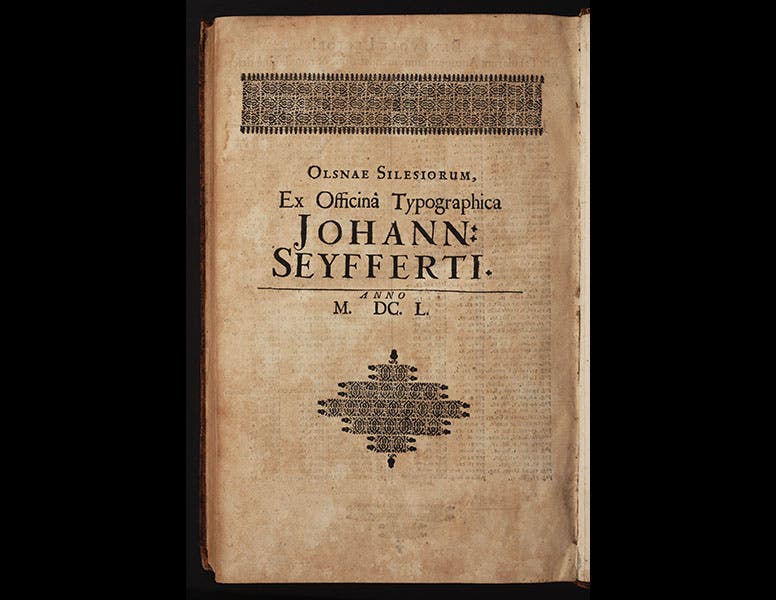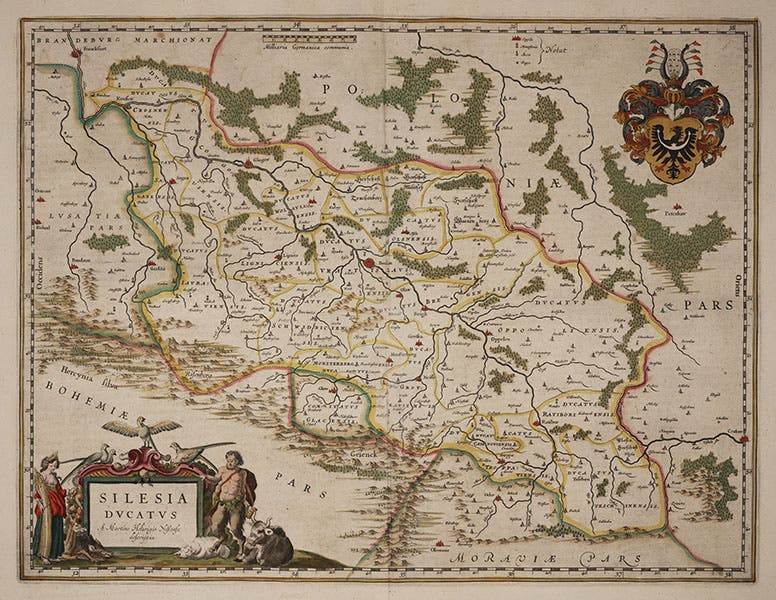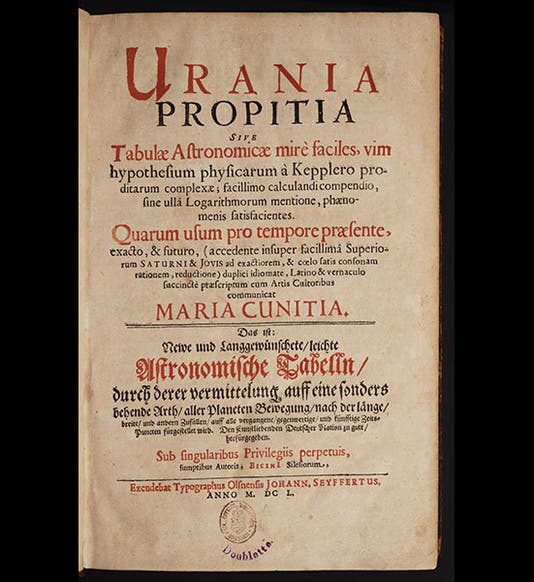Scientist of the Day - Maria Cunitz

Linda Hall Library

Linda Hall Library

Linda Hall Library

Linda Hall Library

Linda Hall Library
Maria Cunitz, a Silesian astronomer, died Aug. 22 (or Aug. 24), 1664, at the age of 60, or perhaps 54 (her birth year is debated; her birth date is unknown). Silesia was then comprised of what is now southwestern Poland, small parts of eastern Germany and some bits of the northern Czech Republic. Maria never had any formal education, but she had educated parents, and she mastered seven languages, it is said, and she somehow acquired great proficiency in mathematical astronomy. She also had the good fortune to marry a physician from Bycznya (Pitschen in German), just up the Oder River from Wrocław (Breslau in German), who supported her astronomical interests. The couple had to flee Silesia for central Poland during part of the Thirty-Years War, and Maria spent her time compiling a set of astronomical tables, based on and updating the Rudolphine Tables (1627) of Johannes Kepler. When Maria and her husband were able to return to Bycznya, Maria published her tables as the Urania propitia (Benevolent Urania). It is an impressive publication – a large quarto with hundreds of pages of tables that allow one to determine the longitude and latitude of each of the planets and a variety of other parameters as well. There had never been anything like it by a woman astronomer. It also contained a preface by her Doctor husband, who wanted to make it perfectly clear to the reader that the Urania propitia was entirely the work of Maria, and that he had nothing to do with it, except for providing encouragement.
We wish we could say that the Urania propitia had a profound impact on late 17th-century astronomy, but it didn’t. It was published at an isolated printing establishment in Olesnica (Oels in German), and there seem to have been few copies printed, and even fewer that were widely distributed. Ismael Boulliau, the mid-century Parisian astronomer, commented on the book (he thought his computations were better), but hardly anyone else mentioned it at all. There are only a few copies of Urania propitia that survive today, and we are very fortunate to have one in our Library. Three of the images above show the title page, a two-page spread of tables for Jupiter and Saturn, and the colophon (last page), where the place of publication - Olsnae Silesiorum - is prominently printed.
Since Silesia is today outside our geographic consciousness, we use this opportunity to show off a map of Silesia from the third volume of Joan Blaeu's Atlas Maior (1662; fourth image). In a detail (fifth image), we can pick out most of the towns and cities associated with Maria Cunitz's life: Wołów, the town where she was born, northwest of the red-colored metropolis that is Wrocław (Brellaw on the map); Świdnica (Sweinitz on the map), southwest of Wrocław, where she grew up; Bycznya (Brigk on the map), just up the Oder from Wrocław ; and Olesnica (marked Olsse on the map), where her book was printed, a short distance northeast of Wrocław (Brellaw).
The city of Świdnica, where she grew up, has erected a monument to Maria, in the form of an iron bench, with a bronze sculpture of Maria sitting upon it, although we have no idea what she really looked like (sixth image). It is the only memorial we know of to one of the most accomplished woman astronomers in the early modern world. If there are others, we would like to learn about them.
Dr. William B. Ashworth, Jr., Consultant for the History of Science, Linda Hall Library and Associate Professor, Department of History, University of Missouri-Kansas City. Comments or corrections are welcome; please direct to ashworthw@umkc.edu.





![Using an astrolabe to measure the depth of a well, woodcut in Elucidatio fabricae vsusq[ue] astrolabii, by Johannes Stöffler, 1513 (Linda Hall Library)](https://assets-us-01.kc-usercontent.com:443/9dd25524-761a-000d-d79f-86a5086d4774/a998eb50-55d2-4a88-ace2-a50aa5fa86e7/Stoffler%201.jpg?w=210&h=210&auto=format&fit=crop)

